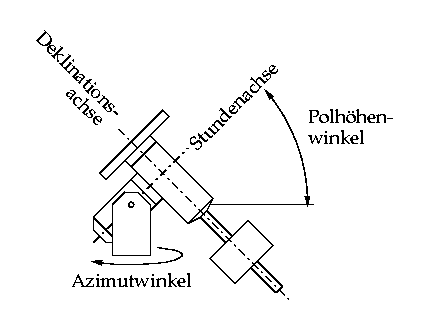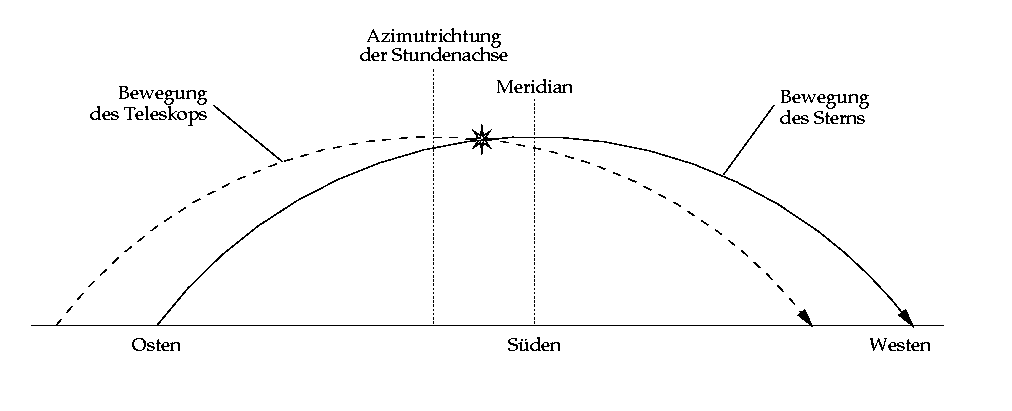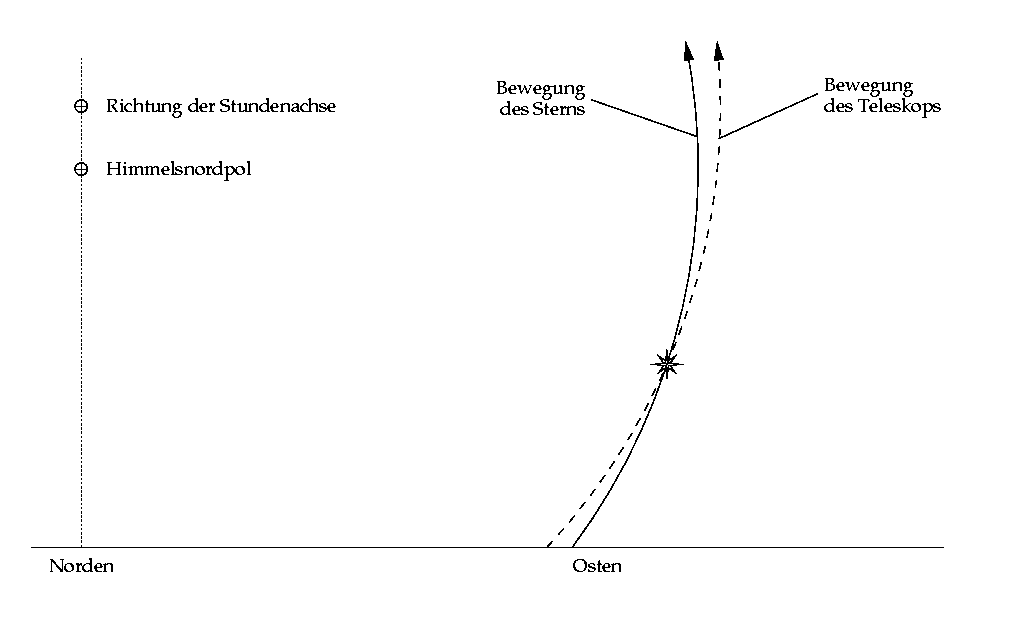The Scheiner Method
Using the Scheiner method, an equatorial mount (e.g. German mount or fork mount) without a polar finder scope can be aligned very accurately with the north celestial pole. With a little practise this can be done within half an hour. A direct view of Polaris is not necessary.
Preparations

The telescope must first be set up as well as possible by hand. It is sufficient to briefly check with the spirit level whether the mount is straight and to roughly aim at Polaris via the hour axis (also called polar or right ascension axis). If the pole star is not visible, the position of the hour axis can be corrected with a compass and an inclinometer or an engraved angle scale. A deviation of a few degrees from the exact position is tolerable and is already sufficient for most visual purposes.
An illuminated crosshair eyepiece is inserted into the focuser of the telescope. If you have a refractor or a Cassegrain, do not use a zenith prism. This makes orientation a little easier. The crosshair eyepiece is best aligned parallel to the two axes, i.e. a centred fixed star runs parallel to a thread out of the image when the telescope is moved back and forth by means of the fine drives. If you have an unlit reticle eyepiece, the image can be brightened somewhat with a weak torch at the objective eye of the telescope.
Azimuth angle correction
Select a suitable star in the south that is a maximum of ±5° from the celestial equator and a maximum of ±1.5 h from the meridian. The crosshairs are now aligned as described above. The tracking motor remains switched on. The inaccurate alignment of the mount causes the guide star to move out perpendicular to the tracking direction - i.e. to the north or south.

Azimuth rule: If the telescope has to be moved north in the declination axis to re-centre the guide star in the crosshairs, the south end of the hour axis will point too far east (see Figure 2). The mount must therefore be rotated clockwise.
If the star moves out of the crosshairs in the other direction (to the north), the azimuth angle must be corrected accordingly in the other direction. The same applies to the following procedures for correcting the polar altitude angle.
The best procedure is to first make a rough change in the angle of the azimuth axis so that you consciously overshoot the target a little. This way you can iteratively approach the correct position from the other side on the next attempt. After each step, wait a few minutes to see in which direction the star moves out of the image and correct accordingly. Repeat this process until the star no longer moves out of the image perpendicular to the tracking direction, but only along it. For alignment in the field to the photografie, it is usually sufficient if the star remains in the centre of the image for about ten minutes with an almost imperceptible deviation.
Pole elevation angle correction
Here, a star above the eastern horizon is chosen at a maximum distance of ±5° from the celestial equator. Because of refraction, however, it should not be too close above the horizon, but also not higher than 20°.

Pole elevation rule (eastern horizon): If the telescope has to be moved north along the declination axis to bring the guide star back into the crosshairs, the polar elevation angle is too steep (compare Figure 3).
Here, too, the crosshairs are to be aligned first. The previously described iterative procedure finds application here as well. If the view of the eastern horizon is obstructed, we use the analogy for the western horizon:
Pole elevation rule (western horizon): If the telescope has to be moved north along the declination axis to bring the guide star back into the crosshairs, the polar elevation angle is too low.
If the mount is to be permanently and accurately aligned for observatory operation, it is recommended to repeat the correction for the azimuth and polar elevation angle iteratively until only the deviation caused by the tracking motor is measurable (e.g. rate inaccuracy, periodic error).
”Scheinering“ in the southern hemisphere
The corrections described above apply to the northern hemisphere. The procedure is analogous for the southern hemisphere. Only the following linguistic modifications are to be made:
- Correction of the azimuth angle: Figure 2 must be mirrored horizontally because the stars move from right to left over the northern horizon. Swap north with south and clockwise with counterclockwise.
- Correct the polar altitude angle: Flip Figure 3 horizontally and swap north with south. Instead of clockwise or counterclockwise, it is also possible to formulate in general terms in the direction of the star's movement, and instead of north or south, the direction of the pole can also be used. However, such a generally formulated instruction would be less clearly understandable.
Literature
- Rolf Riekher: Fernrohre und ihre Meister, Verlag Technik GmbH Berlin, ISBN 3-341-00791-1
- Markus Hägi: Die Ausrichtung des Teleskops nach der Methode von Scheiner, astro sapiens 3/92, Seite 74